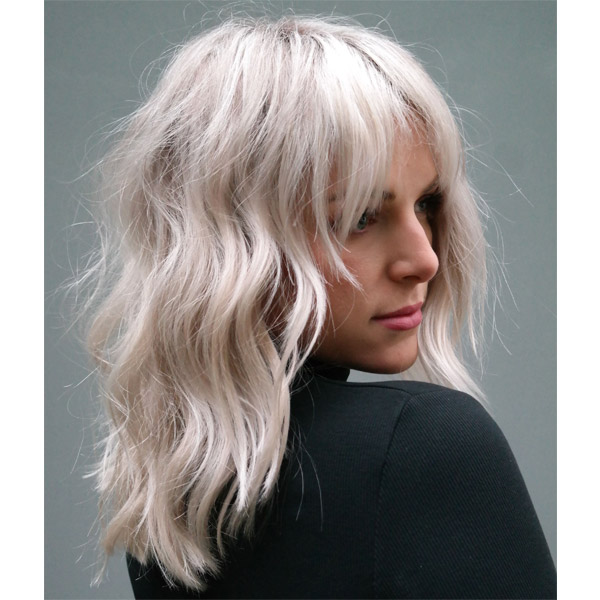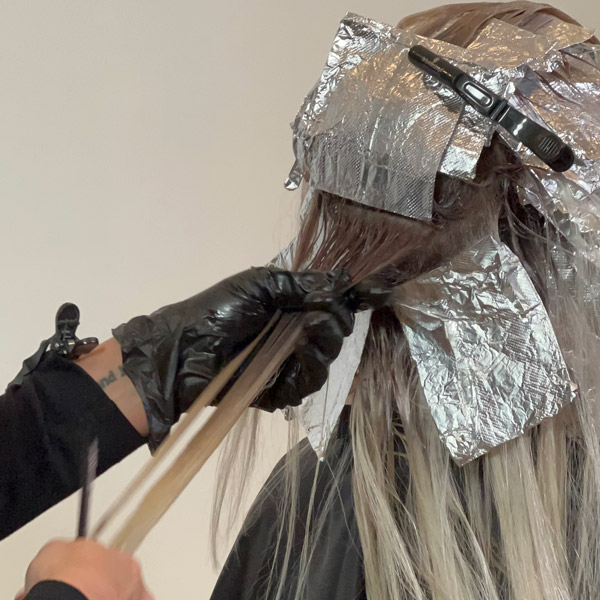Layered Toning: Add Depth To Platinum Blondes
Transitioning Clients from Platinum to Lived-In? Use This Layered Toning Technique
Picture this: Your platinum client is ready for a more lived-in look. After a consultation, you apply a lowlight and add some depth back into her blonde. Then, while drying you see it: A muddy, dull shade. What went wrong? 2021 #ONESHOT Winner Rachel Williams (@rachelwstylist) knows: “Lightened hair is porous, it completely absorbed the toner and the shades muddled together,” she explains.
Her solution: A layered toning technique. A what? Don’t worry fam, we’re breaking it all down below. Want to learn more? Become a BTC-U Member and receive unlimited access to Rachel’s course on BTC University.
What is layered toning?
Instead of mixing one formula that combats warmth, adds depth and creates a reflective shine, layered toning keeps each formula separate, and instead builds each toner on top of each other when applying.
Why? “It allows each toner to do its own thing,” Rachel explains. “My base tone creates depth, the second counters yellow tones. Then, the gold toner creates a customized reflective finish.”
Slide to check out the before & after

Placement: How to determine where to add depth
Stuck on where to begin? Use a highlight placement—no seriously. “It’s that same thought process,” Rachel explains. “I know where I would keep dimension when highlighting, so that is exactly where I place my lowlights to add depth back in,” she adds.
Pro Tip: If you struggle with depth placement, remember this: Teardrop section. Starting at the temples, work horizontally adding lowlights moving towards the center back of the head. Once you reach the occipital bone, drag the root shade down lower to create a pocket of natural depth.
Placement Bonus: Stay organized and repair damage with this foil trick
Rachel applies the KENTE® Bond Hair Mask from SEVEN Haircare to the sections that will remain blonde, isolating them in foils. “This keeps my sections organized and I know exactly where I am maintaining brightness and where I’m adding depth,” she explains. “The bond mask leaves the hair soft and shiny so it is the perfect add-on service for this appointment,” Rachel adds.
Formulation: How to maintain client expectation and avoid muddy results
“You definitely want to stay in the client’s comfort zone,” Rachel explains. “You don’t want to shock them and add tones that significantly change their entire look—unless they request that!” Rachel shared some key things to note when formulating:
- Color match the base. Work with the client’s natural shade to create a soft grow out.
- Consider the color line. “Knowing the underlying pigments in the color line is really important to creating a cohesive look,” Rachel explains. “I know that this particular 6N is a bit warm, so I added a P to achieve a neutral tone,” she adds.
- Maintain the same tonal family. When formulating, keep tones in the same family to avoid muddy results.
Related: Toning Mistakes + Solutions for Platinum Hair
Why is this a great technique for blondes that need a break from lightener?
It’s no secret, being blonde is work. If your client is over the upkeep, this technique is perfect to ease the stress of a strict appointment schedule but still maintain the brightness they are used to without additional lightener.
“It’s the best of both worlds. Clients don’t have to come in every four weeks, and it also gives their hair and scalp a break from continuous lightening. It’s a great technique to ease their grow out and create soft dimension, while maintaining the blonde they are used to,” explains Rachel.
Click on the beaker for Rachel’s full formula breakdown!


More from
SEVEN haircare
-
GAZAR® Blowout Butter
-
Blow Dryers
The Best Kept Secrets For Styling Curtain Bangs
-
Hairsprays
Cubica® Working Spray
-
Texturizers
Cubica® Swept Texture Spray
-
Mousse
Cubica® Mousse Foam
-
Volumizers
Cubica® Loft Volumizer
-
Blonde
3 Foiling Tips For Painting High-Contrast Brondes
-
Business
10 Ways To Increase Appointments, Prebookings and Retail Sales
-
Haircare
Your Client’s Guide To Summer Hair Damage Repair
-
Clarifying
Cubica® CLARIFY shampoo
-
Business
Coronavirus: What To Do When You Have To Close Your Salon
-
Haircare
13 Treatments & Masks Your Clients Will Thank You For
-
Business
How One Salon Sold $70K In Gift Cards In A Single Day
-
BTC Events
BTC “On Tour” Nashville—Here’s How We Closed Out Our 2019 Tour
-
Balayage
3 Shadow Placement Tips For Achieving Depth And Dimension
-
BTC Events
BTC “On Tour” Nashville
-
Industry News
SEVEN Haircare Appoints Sheue Pella As President
-
Blonde
How To Care For Blonde Hair: A Guide For Clients
-
Balayage
WATCH: @lo_wheelerdavis’ Balayage + Toning Technique
-
Conditioners
RINZU® HELIO Violet Shampoo & Conditioner
-
Corrective Color
Corrective Color: Watch @brianacisneros Neutralize Warmth & Ash
-
Brunette
Seamless Chocolate Blend
-
Blowouts
The French Blow-Dry Set: 6 Tips To Do It Perfectly
-
Haircuts
Transformation: Edgy Pixie + Fringe









